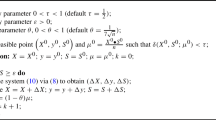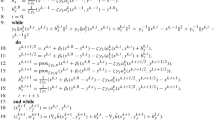Abstract
We describe a primal-dual potential function for linear programming:
whereρ⩾ n, x is the primal variable, ands is the dual-slack variable. As a result, we develop an interior point algorithm seeking reductions in the potential function with\(\rho = n + \sqrt n \). Neither tracing the central path nor using the projective transformation, the algorithm converges to the optimal solution set in\(O(\sqrt n L)\) iterations and uses O(n 3 L) total arithmetic operations. We also suggest a practical approach to implementing the algorithm.
Similar content being viewed by others
References
I. Adler, N. Karmarkar, M.G.C. Resende and G. Veiga, “An implementation of Karmarkar's algorithm for linear programming,”Mathematical Programming 44 (1989) 297–335.
K.M. Anstreicher, “A monotonic projective algorithm for fractional linear programming,”Algorithmica 1 (1986) 483–498.
E.R. Barnes, “A variation on Karmarkar's algorithm for solving linear programming problems,”Mathematical Programming 36 (1986) 174–182.
D.A. Bayer and J.C. Lagarias, “The nonlinear geometry of linear programming: I. Affine and projective scaling trajectories, II. Legendre transform coordinates and central trajectories,”Transactions of the American Mathematical Society 314 (1989) 499–581.
M. Ben Daya and C.M. Shetty, “Polynomial barrier function algorithms for convex quadratic programming,” Report J 88-5, School of ISE, Georgia Institute of Technology (Atlanta, GA, 1988).
G.B. Dantzig,Linear Programming and Extensions (Princeton University Press, Princeton, NJ, 1963).
I.I. Dikin, “Iterative solution of problems of linear and quadratic programming,”Soviet Mathematics Doklady 8 (1967) 674–675.
A.V. Fiacco and G.P. McCormick,Nonlinear Programming: Sequential Unconstrained Minimization Techniques (Wiley, New York, NY, 1968).
K.R. Frisch, “The logarithmic potential method of convex programming,” Technical Report, University Institute of Economics (Oslo, Norway, 1955).
D.M. Gay, “A variant of Karmarkar's linear programming algorithm for problems in standard form,”Mathematical Programming 37 (1987) 81–90.
G. de Ghellinck and J.-P. Vial, “A polynomial Newton method for linear programming,”Algorithmica 1 (1986) 425–454.
P.E. Gill, W. Murray, M.A. Saunders, J.A. Tomlin and M.H. Wright, “On projected Newton barrier methods for linear programming and an equivalence to Karmarkar's projective method,”Mathematical Programming 36 (1986) 183–209.
D. Goldfarb and S. Liu, “An O(n 3 L) primal interior point algorithm for convex quadratic programming,” Technical Report, Department of IEOR, Columbia University (New York, NY, 1988).
C.C. Gonzaga, “Polynomial affine algorithms for linear programming,”Mathematical Programming 49 (1991) 7–21.
C.C. Gonzaga, “An algorithm for solving linear programming problems in O(n 3 L) operations,” in: N. Megiddo, ed.,Progress in Mathematical Programming, Interior Point and Related Methods (Springer, New York, 1988) pp. 1–28.
M. Iri and H. Imai, “A multiplicative barrier function method for linear programming,”Algorithmica 1 (1986) 455–482.
N. Karmarkar, “A new polynomial-time algorithm for linear programming,”Combinatorica 4 (1984) 373–395.
M. Kojima, S. Mizuno and A. Yoshise, “A polynomial-time algorithm for a class of linear complementarity problems,”Mathematical Programming 44 (1989) 1–26.
K.O. Kortanek and M. Shi, “Convergence results and numerical experiments on a linear programming hybrid algorithm,”European Journal of Operations Research 32 (1987) 47–61.
K.A. McShane, C.L. Monma and D.F. Shanno, “An implementation of a primal-dual interior point method for linear programming,”ORSA Journal on Computing 1 (1989) 70–83.
N. Megiddo, “Pathways to the optimal set in linear programming,” in: N. Megiddo, ed.,Progress in Mathematical Programming, Interior Point and Related Methods (Springer, New York, 1988) 131–158.
N. Megiddo and M. Shub, “Boundary behavior of interior point algorithms in linear programming,”Mathematics of Operations Research 14 (1989) 97–146.
S. Mehrotra and J. Sun, “An algorithm for convex quadratic programming that requires O(n 3.5 L) arithmetic operations,”Mathematics of Operations Research 15 (1990) 342–363.
C.L. Monma and A.J. Morton, “Computational experimental with a dual affine variant of Karmarkar's method for linear programming,” Technical Report, Bell Communications Research (Morristown, NJ, 1987).
R.C. Monteiro, I. Adler and M.C. Resende, “A polynomial-time primal-dual affine scaling algorithm for linear and convex quadratic programming and its power series extension,”Mathematics of Operations Research 15 (1990) 191–214.
R.C. Monteiro and I. Adler, “Interior path following primal-dual algorithms. Part I: Linear programming,”Mathematical Programming 44 (1989) 27–42.
J. Renegar, “A polynomial-time algorithm, based on Newton's method, for linear programming,”Mathematical Programming 40 (1988) 59–93.
D.F. Shanno, “Computing Karmarkar projection quickly,”Mathematical Programming 41 (1988) 61–71.
G. Sonnevend, “An analytical center for polyhedrons and new classes of global algorithms for linear (smooth, convex) programming,” in:Lecture Notes in Control and Information Sciences No. 84 (Springer, New York, 1985) pp. 866–876.
M.J. Todd and B.P. Burrell, “An extension of Karmarkar's algorithm for linear programming using dual variables,”Algorithmica 1 (1986) 409–424.
M.J. Todd and Y. Ye, “A centered projective algorithm for linear programming,”Mathematics of Operations Research 15 (1990) 508–529.
P.M. Vaidya, “An algorithm for linear programming which requires O((m+n)n 2+(m+n) 1.5 n)L) arithmetic operations,”Mathematical Programming 47 (1990) 175–201.
R.J. Vanderbei and J.C. Lagarias, “I.I. Dikin's convergence result for the affine-scaling algorithm,” manuscript, AT&T Bell Laboratories (Murray Hill, NJ, 1988).
R.J. Vanderbei, M.S. Meketon and B.A. Freedman, “On a modification of Karmarkar's linear programming algorithm,”Algorithmica 1 (1986) 395–407.
Y. Ye, “Interior algorithms for linear, quadratic, and linearly constrained convex programming,” Ph.D. Thesis, Department of Engineering-Economic Systems, Stanford Universty (Stanford, CA, 1987).
Y. Ye and M. Kojima, “Recovering optimal dual solutions in Karmarkar's polynomial algorithm for linear programming,”Mathematical Programming 39 (1987) 305–317.
Y. Ye and M.J. Todd, “Containing and shrinking ellipsoids in the path-following algorithm,”Mathematical Programming 47 (1990) 1–9.
Author information
Authors and Affiliations
Rights and permissions
About this article
Cite this article
Ye, Y. An O(n 3 L) potential reduction algorithm for linear programming. Mathematical Programming 50, 239–258 (1991). https://doi.org/10.1007/BF01594937
Received:
Revised:
Issue Date:
DOI: https://doi.org/10.1007/BF01594937




